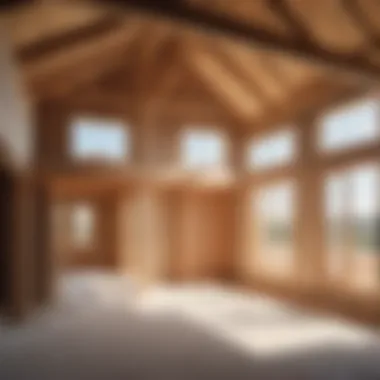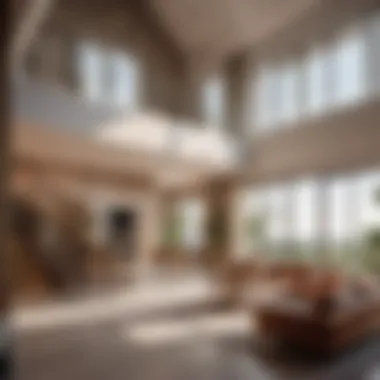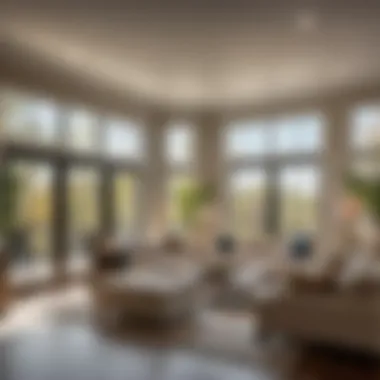Materials:
- Lumber: 2x4 studs (quantity: 200 pieces, measurement: 8 feet in length), engineered wood joists (quantity: 50 pieces, measurement: 16 feet in length)
- Plywood: 3/4 inch thick plywood sheets (quantity: 25 sheets, measurement: 4 feet by 8 feet)
- Nails: 3-inch framing nails, 2-inch finishing nails
- Insulation: R-19 fiberglass insulation (quantity: enough to cover the new floor area)
- Drywall: 1/2 inch drywall sheets (quantity: 30 sheets, measurement: 4 feet by 10 feet)
- Roofing materials: shingles, underlayment
DIY Steps:
- Design and Planning: Consult with an architect or designer to create blueprints for the second story addition. Check local building codes and obtain necessary permits.
- Foundation Preparation: Strengthen the existing foundation to support the additional load of the second story.
- Frame Construction: Build the structural framework for the new level using the lumber and engineered wood joists.
- Flooring and Insulation: Install plywood subflooring and R-19 insulation for energy efficiency.
- Wall Construction: Erect interior and exterior walls, leaving spaces for windows and doors.
- Roofing: Install roofing materials, ensuring proper sealing and drainage.
- Electrical and Plumbing: Wire the new level for electrical outlets and lighting, and run plumbing lines for bathrooms and sinks.
- Drywall and Finishing: Hang drywall sheets, tape, mud, and sand seams for a smooth finish.
- Painting and Flooring: Add final touches by painting walls and installing flooring for a polished look.
Technical Aspects:
- Tools: Hammer, nails, circular saw, level, drill, tape measure, ladder
- Timing: Allow 3-6 months for completion, depending on the size of the project
- Techniques: Use advanced framing techniques to optimize material usage and structural integrity
DIY Project Process:


- Step 1: Design and Planning: Engage professionals to create detailed plans and obtain necessary permits.
- Step 2: Foundation Preparation: Reinforce the existing foundation and footings to support the additional weight.
- Step 3: Frame Construction: Erect walls and secure them with proper bracing to ensure stability.
- Step 4: Floor and Roof Installation: Lay subflooring and roofing materials, ensuring waterproofing and insulation.
- Step 5: Electrical and Plumbing: Install electrical wiring and plumbing fixtures according to building codes.
- Step 6: Finishing Touches: Complete the project with drywall, paint, flooring, and trim work for a polished appearance.
Troubleshooting Tips:


- Sagging Floors: Add additional support beams to prevent floor sagging over time.
- Leaks: Seal all openings thoroughly to avoid water leaks and damage to the new structure.
- Code Violations: Regularly consult with inspectors to ensure compliance with local building codes.
- Insufficient Insulation: Upgrade insulation as needed to maintain energy efficiency and comfort.
Introduction


In the realm of home improvement projects, the decision to add a second story to your house stands out as a bold and transformative endeavor. This multi-faceted guide delves deep into the feasibility, benefits, challenges, and considerations associated with this architectural feat. For homeowners seeking to maximize their living space within a limited footprint, the prospect of vertical expansion opens up a realm of possibilities. From understanding the structural requirements to navigating zoning regulations and budget constraints, every aspect of this project will be meticulously explored in the following sections.
Understanding the Feasibility
Evaluating Structural Integrity
When considering the addition of a second story to your home, one of the crucial factors that demand attention is the evaluation of structural integrity. This involves a thorough assessment of your current building's ability to support the added weight and modifications. By engaging the expertise of structural engineers, you can gain invaluable insights into the feasibility and required reinforcements for a successful vertical expansion. Understanding the structural integrity sets the foundation for a safe and enduring second-story addition.
Assessing Zoning Regulations
Navigating the complex landscape of zoning regulations is paramount when embarking on a second-story addition. The careful assessment of local building codes and ordinances ensures compliance and smooth progression throughout the project. By having a clear understanding of zoning restrictions, setbacks, and height limitations, homeowners can proceed with confidence, knowing that their addition aligns with legal requirements. Adhering to zoning regulations safeguards the structural integrity and aesthetics of the new construction.
Considering Budget Constraints
Among the array of factors influencing the decision to add a second story, budget constraints play a pivotal role in shaping the project's scope and scale. From material costs to labor expenses, meticulous budget planning is essential to avoid cost overruns and financial strain. Balancing the aspiration for vertical expansion with realistic budget projections equips homeowners with a practical outlook on the financial commitments involved. Scrutinizing budget constraints ensures a well-managed and cost-effective second-story addition.
Benefits of Adding a Second Story
Expanding Living Space
The primary allure of adding a second story lies in the substantial increase in living space it offers. By expanding vertically, homeowners can optimize their property's square footage without encroaching on precious outdoor area. This expansion provides room for additional bedrooms, bathrooms, or recreational spaces, catering to evolving lifestyle needs. Embracing the concept of multi-level living redefines comfort and functionality within the existing structure.
Increasing Property Value
Beyond immediate functionality, the addition of a second story positions the property for enhanced market value. The increased square footage and modernized design not only elevate the aesthetic appeal but also contribute to a higher appraisal value. This investment in vertical expansion yields long-term returns by boosting the overall worth of the property, making it a lucrative asset in the real estate market.
Enhancing Aesthetic Appeal
Aesthetically, the addition of a second story introduces a new dimension of architectural charm to the existing structure. Whether aligning with the original design or introducing a contemporary facade, the vertical expansion enhances the visual impact of the house. The cohesive integration of the new story harmonizes with the overall architecture, creating a seamless and stylish transition that elevates the property's curb appeal.
Challenges and Considerations
Structural Modifications
Undertaking structural modifications for a second-story addition involves intricate alterations to the existing framework. Reinforcing load-bearing walls, redistributing weight, and ensuring structural integrity demand meticulous planning and execution. Addressing these modifications effectively is critical to the project's success, as any oversight could compromise the safety and stability of the entire structure.
Building Permits and Approvals
Securing the necessary building permits and approvals is a fundamental step in the process of adding a second story. Compliance with local building codes and regulations is essential to avoid legal complications and ensure the structural soundness of the new addition. Navigating the permit process requires attention to detail and adherence to specific guidelines to obtain official authorization for the construction project.
Safety and Accessibility
Maintaining safety standards and accessibility throughout the construction phase is paramount for a seamless second-story addition. Implementing safety protocols, providing adequate structural support, and ensuring accessibility features for all occupants promote a secure living environment. Prioritizing safety and accessibility considerations enhances the functionality and usability of the newly expanded space, catering to the diverse needs of homeowners.
Initial Planning Steps
Consulting with Architects and Engineers
Collaborating with architects and engineers from the initial planning stages sets the foundation for a successful second-story addition. The expertise of professionals in designing structural elements, incorporating aesthetic enhancements, and ensuring compliance with building codes is invaluable. Consulting with experts streamlines the planning process, aligning the vision for the project with practical considerations and technical requirements.
Designing the Layout
Designing the layout of the second story involves meticulous attention to spatial organization, flow, and functionality. Optimizing the arrangement of bedrooms, bathrooms, common areas, and circulation spaces defines the usability and comfort of the new living quarters. Incorporating innovative design elements and ergonomic solutions creates a harmonious environment that caters to the lifestyle preferences of the homeowners.
Estimating Costs
Accurately estimating costs is a fundamental aspect of the planning phase for a second-story addition. From material selection to labor expenses, every aspect of the project must be budgeted with precision to avoid financial setbacks. By conducting a thorough cost analysis and factoring in contingencies, homeowners can set realistic budget limits and ensure a smooth progression of the construction process.
This detailed guide to adding a second story to your house encompasses a spectrum of considerations, from structural requirements to aesthetic enhancements, offering homeowners a comprehensive roadmap for vertical expansion. Each section unveils critical aspects of the project, weaving together insights and expert advice to empower readers with the knowledge and confidence to embark on this transformative endeavor.
Structural Preparation
In the process of adding a second story to a house, structural preparation plays a vital role in ensuring the integrity and safety of the overall structure. It involves a detailed assessment of the existing foundation, framework, and support systems to determine their capabilities to support the additional weight and construction overhead. Structural preparation is crucial as any compromise in this phase can lead to structural weaknesses or failures in the new addition. Homeowners need to prioritize this step to guarantee a stable and durable final result that adheres to building standards and regulations.
Foundation Reinforcement
Assessment by Structural Engineer:
An assessment by a structural engineer is a pivotal aspect of foundation reinforcement when adding a second story. The engineer evaluates the current foundation's capacity, identifying potential weaknesses and recommending necessary reinforcement measures. Their expertise ensures that the new structure will be adequately supported and will meet safety requirements. This assessment not only provides a detailed understanding of the structural integrity but also guides subsequent decisions in the construction process. Homeowners benefit from the comprehensive evaluation and professional recommendations, which contribute to a smooth and secure project execution.
Implementing Reinforcement Measures:
Implementing reinforcement measures based on the structural engineer's assessment is essential for strengthening the foundation. This step may include adding additional concrete supports, installing steel beams, or upgrading existing pillars to enhance load-bearing capacity. By implementing these measures, homeowners ensure that the foundation can effectively support the added weight and structural modifications of the second story. While these enhancements incur additional costs and construction time, they are indispensable for the overall stability and longevity of the property. Proper reinforcement measures mitigate risks and guarantee a durable and resilient structure that meets industry standards.
Framework and Support Systems
When considering framework and support systems for the second story addition, attention to detail and precision are fundamental to the success of the project. Installing a robust framework that aligns with architectural plans and load requirements is critical for the structural integrity of the new floor. Similarly, ensuring the load-bearing capacity of existing support systems is vital to prevent structural issues over time. Homeowners must prioritize these aspects to create a secure and functional second-story extension that complements the existing dwelling.
Installing Framework for Second Story:
Installing the framework for the second story involves constructing the skeletal structure that will form the basis of the new level. This phase demands precision in placement and alignment to support the additional weight and construction elements. The choice of materials and construction techniques influences the overall strength and stability of the framework, emphasizing the importance of skilled labor and adherence to engineering plans. Homeowners benefit from a well-executed framework installation, as it establishes the groundwork for a successful second-story build that meets quality standards and design expectations.
Ensuring Load-Bearing Capacity:
Ensuring the load-bearing capacity of support systems is a critical consideration when adding a second story. Structural modifications may require reinforcing existing beams, columns, or walls to accommodate the increased weight and structural demands. By verifying and enhancing load-bearing capabilities, homeowners safeguard their property against structural failures and maintain long-term structural soundness. This proactive approach to load-bearing capacity optimization contributes to the overall safety and functionality of the expanded living space, offering peace of mind and longevity to the structure.
Electrical and Plumbing Considerations
Incorporating electrical and plumbing considerations into the second-story addition project is essential for a cohesive and functional living space. Rerouting electrical wiring and extending plumbing lines requires meticulous planning and execution to ensure seamless integration with the existing systems. Homeowners must prioritize these aspects to guarantee proper functionality and convenience in the newly expanded area.
Rerouting Electrical Wiring:
Rerouting electrical wiring involves the careful relocation of electrical lines to accommodate the new layout and electrical needs of the second story. This process demands expertise to avoid electrical hazards and ensure compliance with building codes. By strategically rerouting wiring pathways, homeowners can optimize electrical efficiency and safety in the expanded space. While this task may involve intricate work and potential disruptions, the benefits of proper electrical rerouting extend to improved functionality, aesthetics, and safety in the renovated area.
Extending Plumbing Lines:
Extending plumbing lines is a crucial aspect of adding a second story that necessitates precision and attention to detail. Connecting new plumbing fixtures and fittings to the existing system requires skillful coordination to maintain proper water flow and drainage. Homeowners should consider factors such as pipe accessibility, ventilation requirements, and compliance with plumbing standards during the extension process. Extending plumbing lines accurately contributes to the overall functionality and convenience of the second story, enhancing the livability and usability of the extended space.
Construction Process
In the journey of adding a second story to your house, the construction process plays a pivotal role. This phase involves significant physical transformations to your home and requires meticulous planning and execution. Understanding the nuances of the construction process is vital for ensuring a successful outcome for your project. It encompasses various key elements that contribute to the structural integrity, functionality, and aesthetic appeal of your expanded living space. By delving into the construction process, homeowners can envision their dream second story taking shape.
Building the Second Story
Demolition of Existing Roof
The demolition of the existing roof marks the beginning of the second story construction and is a critical step in the transformation process. This phase involves carefully removing the old roof to make way for the new structure. The key characteristic of demolition is the controlled dismantling of the roof to pave the path for the upcoming construction. While it may seem disruptive, the demolition phase is imperative for creating a sturdy foundation for the second story. One of the key advantages of demolishing the existing roof is the opportunity to address any underlying issues and ensure a fresh start for the construction of the new story. However, it is essential to consider the potential disruptions and safety measures during this phase.
Construction of Walls and Roof for Second Story
Following the demolition phase, the construction of walls and the roof for the second story takes center stage. This crucial aspect involves erecting the structural framework that will define the new living space. The key characteristic of this phase is the meticulous assembly of walls and roof elements to create a sturdy and functional structure. The construction of walls and the roof sets the stage for defining the layout and design of the second story. It is a popular choice for homeowners as it allows for customization and ensures the structural integrity of the new addition. While offering flexibility in design, this phase also requires careful attention to detail to guarantee a seamless integration with the existing structure and optimal load-bearing capacity.
Interior Finishing
Drywall Installation
The interior finishing phase of adding a second story includes drywall installation, which plays a significant role in enhancing the visual appeal and functionality of the new space. Drywall installation involves mounting the gypsum boards to create walls and ceilings, providing a smooth surface for painting or wallpapering. The key characteristic of drywall installation is its ability to create a polished and uniform look for the interior spaces. It is a popular choice for its cost-effectiveness and ease of installation, making it a preferred option for many homeowners. However, considerations such as moisture resistance and durability should be taken into account when opting for drywall installation.
Flooring and Paintwork
Another essential aspect of interior finishing is flooring and paintwork, which add the final touches to the second story. Installing suitable flooring material and applying high-quality paint not only enhances the aesthetic appeal but also ensures durability and functionality. The key characteristic of flooring and paintwork is the ability to personalize the space and create a cohesive design theme. Choosing the right flooring material and paint colors is crucial for achieving the desired ambiance and style. While providing endless design possibilities, it is important to consider factors such as maintenance requirements and durability to select the most suitable options for your second story.
Integration and Maintenance
Connecting Utilities
Integrating utilities such as electricity, plumbing, and HVAC systems into the second story is paramount for ensuring functionality and convenience. Connecting utilities involves extending electrical wiring, plumbing lines, and ventilation to cater to the new living space. The key characteristic of this phase is the seamless integration of essential utilities to support daily activities in the expanded area. It is a beneficial choice as it maximizes comfort and usability while adhering to safety standards. However, proper planning and coordination with utility providers are essential to avoid potential complications and ensure efficient connectivity.
Regular Maintenance Checks
Incorporating regular maintenance checks as part of your routine is crucial for preserving the longevity and efficiency of your second story. Conducting periodic inspections of the structure, systems, and finishes can help identify and address any issues promptly, preventing costly repairs in the future. The key characteristic of regular maintenance checks is the proactive approach to ensuring the optimal performance and condition of the newly added space. It is a popular choice for homeowners seeking to protect their investment and uphold the value of their property. By scheduling regular maintenance checks, you can address minor issues early on and maintain a safe and comfortable living environment for years to come.
Finalization and Inspection
In the realm of adding a second story to your house, the significance of finalization and inspection cannot be overstated. This phase marks the culmination of meticulous planning and dedicated construction efforts, ensuring that the newly added second story meets all safety and regulatory requirements. Finalization and inspection encompass critical aspects that guarantee the structural integrity and compliance of the project.
Code Compliance and Inspections
Local Building Codes:
Local building codes play a pivotal role in dictating the standards and specifications that must be adhered to when adding a second story to a residential property. These codes serve as the regulatory framework, encompassing essential guidelines related to structural design, safety measures, and occupancy limits. Compliance with local building codes is not just a recommendation but a legal necessity to ensure the structural soundness and habitability of the expanded living space.
Inspection by Authorities:
The inspection process conducted by relevant authorities serves as a final checkpoint to validate that the construction of the second story aligns with the approved plans and complies with all applicable regulations. Authorities meticulously scrutinize various aspects, including the structural stability, adherence to building codes, and safety features. This thorough inspection guarantees that the newly added space meets the required standards and can be safely occupied.
Completion and Handover
The final stages of adding a second story to your house involve crucial steps to complete the project and hand it over for occupancy. From final touches to contractor walkthroughs, each element contributes to the successful culmination of the endeavor, ensuring a seamless transition to enjoying the newly expanded living space.
Final Touches and Clean-Up:
Final touches and clean-up are essential tasks that add the finishing polish to the project. This phase involves meticulous attention to detail, addressing any remaining construction debris, and ensuring that the interior and exterior spaces are pristine and ready for occupancy. By focusing on final touches and clean-up, homeowners can revel in a beautifully refined and move-in-ready second story.
Walkthrough with Contractor:
Conducting a walkthrough with the contractor allows homeowners to gain valuable insights into the completed project and address any final concerns or adjustments. This interactive process enables effective communication between the homeowner and contractor, facilitating a smooth handover of the project. A walkthrough with the contractor ensures that all aspects of the construction meet expectations and any minor issues are promptly resolved.





